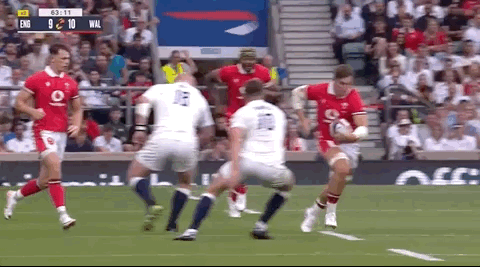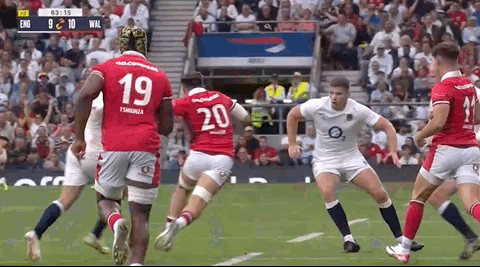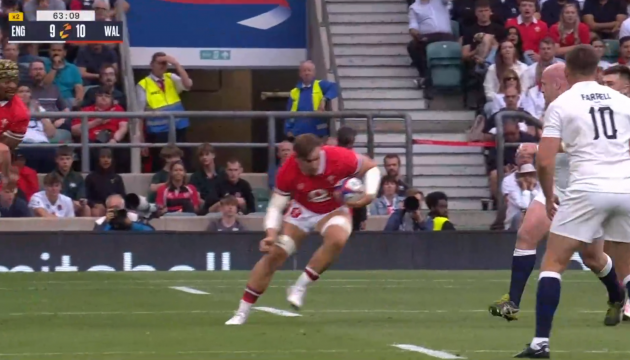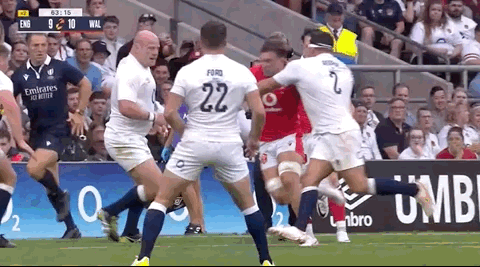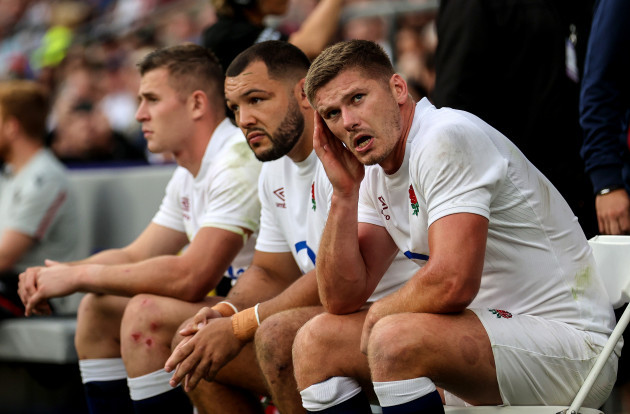WHEN THE DISCIPLINARY committees themselves are pointing out that there’s no consistency, you know you’ve got a problem.
While considering the Johnny Sexton case, the independent committee said that when it came to disciplinary decisions related to abuse or disrespect of match officials, “it is sometimes difficult to discern consistency in the assessment of seriousness.”
The Sexton case was different in subject matter from Owen Farrell’s but the underlying point about consistency is a key one. Rugby’s disciplinary process is reliably inconsistent. Even in the realm of dangerous high tackles involving head contact, it seems difficult to get everyone on the same page.
The latest example is the shock decision to overturn England captain Farrell’s red card against Wales. There had been widespread expectation that Farrell was facing a ban, the question being whether he would miss the World Cup. An independent committee made up of three Australians – Adam Casselden, John Langford, and David Croft – didn’t agree. They rescinded the red card.
Let’s consider the incident in last weekend’s game.
Wales back row Taine Basham is making a slaloming carry when he is tackled by Farrell.
At the next break in play, TMO Brian MacNeice calls for a formal review and after two replays, match referee Nika Amashukeli shows Farrell a yellow card and sends the incident to the ‘bunker’ for review.
The unnamed Foul Play Review Officer [World Rugby hasn't been announcing these officials publicly] takes five minutes of game time – around seven minutes of real time – to decide it’s a red card due to the high degree of danger and lack of mitigation. The FPRO is entitled to eight minutes of game time but didn’t feel they needed the full allotment here.
After the game, the incident was referred to an independent judicial hearing which took place today. This was not a World Rugby-run hearing. Indeed, it’s understood World Rugby and Six Nations Rugby, the organiser of World Cup warm-ups, have the right to appeal the ruling made by this committee. The decision does seem at odds with everything World Rugby has been trying to do in relation to head injuries.
The key point in what the committee communicated today through Six Nations Rugby is that they felt there was mitigation that should have been considered by the Foul Play Review Officer [FPRO].
Specifically, that England hooker Jamie George’s involvement brought about “a sudden and significant change in direction” from Basham before the contact from Farrell, meaning a “late change in dynamics.”
As we can see above, Basham does move across the five-metre line but the contact from George is not strong.
It’s a matter of opinion, of course, but to call the resulting change of direction “significant” seems a stretch.
It appears that Farrell’s intention here is to target the ball, something he does regularly, either attempting choke tackles by wrapping the ball up or dislodging it from the ball-carrier’s grasp by connecting directly with the ball and/or using an arm to simultaneously strip it away.
Yet we have come to expect that intent is not crucial in these incidents. It’s exceedingly rare that someone goes onto the pitch trying to hit people in the head. But players do get their technique wrong and commit foul play in a reckless manner.
Farrell has been guilty of that on several occasions in the past. He lives on the edge and occasionally slips over it.
We can see above that Farrell has around 20 metres in which to assess Basham’s run. As he considers his tackle technique, Farrell must appreciate that it’s not going to be an uncomplicated collision.
Farrell still decides to go upright into the tackle to target the ball. There’s a possibility of dislodging the ball but there’s also an inherent danger of making contact with Basham’s head given Farrell’s height into the tackle.
That danger of head contact becomes the reality and Basham is forced off for a Head Injury Assessment that he fails.
Farrell drives up into the contact – it’s hard to argue that he’s ‘passive’ or absorbs the collision – and leads with his right shoulder into the head of Basham. While his left arm does wrap up onto Basham, his right arm doesn’t wrap in under the ball due to the contact from his shoulder onto Basham’s head.
Given everything we have seen in recent times, it looks like a red card.
But Farrell did not accept that his actions warranted a red card at today’s hearing. He did acknowledge that it was foul play, but he argued his tackle wasn’t worthy of a red. There was a risk in doing so – a longer ban – but the committee agreed.
There has been much discussion of Farrell’s previous three bans for high tackles but they may not have even come into consideration at the hearing given the committee felt he didn’t deserve a red card in this instance. Farrell’s history would have been extremely relevant if the committee were figuring out how long he should be banned for.
Farrell and England’s lawyer, Richard Smith KC, played a blinder in arguing that there was mitigation involved and have come away with a huge win for the English captain.
For the rest of us, the confusion grows. It’s not just fans who are bemused by this decision. Some players, coaches, and referees are in the same boat. This also points to the disconnect between match officials who are making these decisions during games and the disciplinary officers who pore over them afterward.
The feeling among top-level officials is that they’re too often hung out to dry by these decisions, some of which seem to be at odds with how the referees have been told to adjudicate by World Rugby. That said, we can speculate that other disciplinary officers would have been of the opinion that Farrell deserved a red card and ban here.
And there’s a new element to consider – the bunker system that’s still on trial but is expected to feature at the World Cup. The committee in the Farrell case plainly stated that the anonymous FPRO was “wrong” but added that this shouldn’t be perceived as criticism.
The committee said they had the “luxury of time” to consider the incident “in private”, rather than the FPRO’s “matter of minutes without the benefit of all the additional material including hearing from the player and his legal representative.”
This is a striking statement given that the bunker was brought in to ensure foul play decisions could be made with more time and away from the pressurising glare of the TV cameras and watching fans.
In short, it’s a bit of a mess. We’ve argued many times before that World Rugby should centralise the disciplinary process, appointing full-time disciplinary officers. The desire for ‘independent’ decisions is understandable, but surely everyone in the game would get on board with a system run by World Rugby that could produce more consistent decisions and concise, clear communication around what is and isn’t acceptable. At least then we’d all know where we stand.
At the moment, it’s a guessing game.


